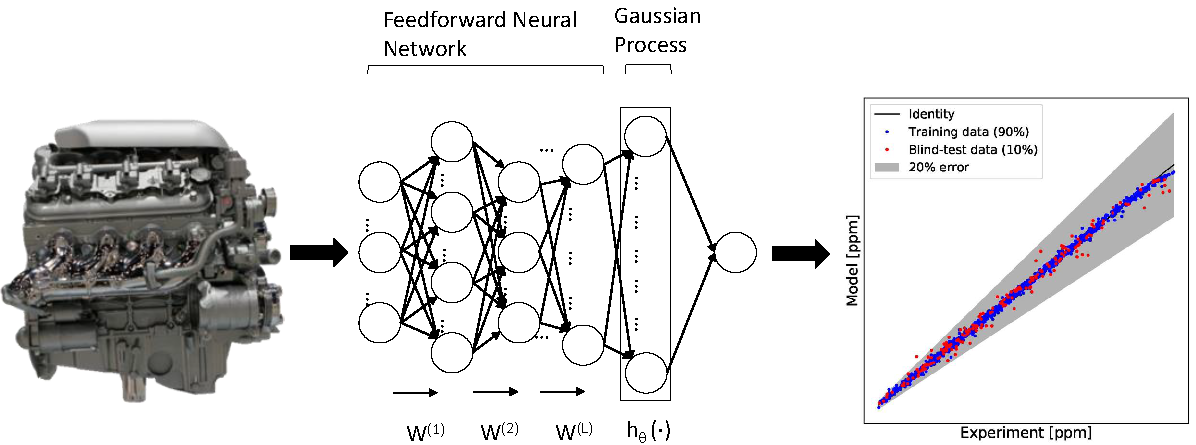Deep kernel learning approach to engine emissions modeling
- The application of DKL as a surrogate model to engine emissions is explored.
- A 14-dimensional dataset of emissions from a compression ignition engine is studied.
- Hyperparameters in DKL are systematically optimised.
- DKL outperforms plain GPs, DNNs, and HDMR on the considered dataset.
- A preprint is also available here from CMCL Innovations.
 We apply deep kernel learning (DKL), which can be viewed as a combination of a Gaussian process (GP) and a deep neural network (DNN), to compression ignition engine emissions and compare its performance to a selection of other surrogate models on the same dataset. Surrogate models are a class of computationally cheaper alternatives to physics-based models. High-dimensional model representation (HDMR) is also briefly discussed and acts as a benchmark model for comparison. We apply the considered methods to a dataset, which was obtained from a compression ignition engine and includes as outputs soot and NOx emissions as functions of 14 engine operating condition variables. We combine a quasi-random global search with a conventional grid-optimization method in order to identify suitable values for several DKL hyperparameters, which include network architecture, kernel, and learning parameters. The performance of DKL, HDMR, plain GPs, and plain DNNs is compared in terms of the root mean squared error (RMSE) of the predictions as well as computational expense of training and evaluation. It is shown that DKL performs best in terms of RMSE in the predictions whilst maintaining the computational cost at a reasonable level, and DKL predictions are in good agreement with the experimental emissions data.
We apply deep kernel learning (DKL), which can be viewed as a combination of a Gaussian process (GP) and a deep neural network (DNN), to compression ignition engine emissions and compare its performance to a selection of other surrogate models on the same dataset. Surrogate models are a class of computationally cheaper alternatives to physics-based models. High-dimensional model representation (HDMR) is also briefly discussed and acts as a benchmark model for comparison. We apply the considered methods to a dataset, which was obtained from a compression ignition engine and includes as outputs soot and NOx emissions as functions of 14 engine operating condition variables. We combine a quasi-random global search with a conventional grid-optimization method in order to identify suitable values for several DKL hyperparameters, which include network architecture, kernel, and learning parameters. The performance of DKL, HDMR, plain GPs, and plain DNNs is compared in terms of the root mean squared error (RMSE) of the predictions as well as computational expense of training and evaluation. It is shown that DKL performs best in terms of RMSE in the predictions whilst maintaining the computational cost at a reasonable level, and DKL predictions are in good agreement with the experimental emissions data.
- This paper draws from preprint 243: Deep Kernel Learning Approach to Engine Emissions Modelling
- Access the article at the publisher: DOI: 10.1017/dce.2020.4



